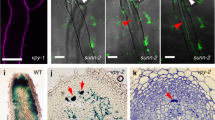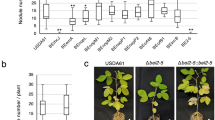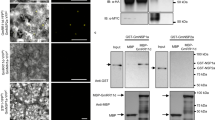Abstract
Plants belonging to the legume family develop nitrogen-fixing root nodules in symbiosis with bacteria commonly known as rhizobia. The legume host encodes all of the functions necessary to build the specialized symbiotic organ, the nodule, but the process is elicited by the bacteria1,2,3. Molecular communication initiates the interaction, and signals, usually flavones, secreted by the legume root induce the bacteria to produce a lipochitin-oligosaccharide signal molecule (Nod-factor), which in turn triggers the plant organogenic process4,5,6,7. An important determinant of bacterial host specificity is the structure of the Nod-factor, suggesting that a plant receptor is involved in signal perception and signal transduction initiating the plant developmental response8,9. Here we describe the cloning of a putative Nod-factor receptor kinase gene (NFR5) from Lotus japonicus. NFR5 is essential for Nod-factor perception and encodes an unusual transmembrane serine/threonine receptor-like kinase required for the earliest detectable plant responses to bacteria and Nod-factor. The extracellular domain of the putative receptor has three modules with similarity to LysM domains known from peptidoglycan-binding proteins and chitinases. Together with an atypical kinase domain structure this characterizes an unusual receptor-like kinase.
This is a preview of subscription content, access via your institution
Access options
Subscribe to this journal
Receive 51 print issues and online access
$199.00 per year
only $3.90 per issue
Buy this article
- Purchase on Springer Link
- Instant access to full article PDF
Prices may be subject to local taxes which are calculated during checkout



Similar content being viewed by others
References
Truchet, G. et al. Alfalfa nodulation in the absence of Rhizobium. Mol. Gen. Genet. 219, 65–68 (1989)
Truchet, G. et al. Sulphated lipo-oligosaccharide signals of Rhizobium meliloti elicit root nodule organogenesis in alfalfa. Nature 351, 670–673 (1991)
Spaink, H. P. et al. A novel highly unsaturated fatty acid moiety of lipo-oligosaccharide signals determines host specificity of Rhizobium. Nature 354, 125–130 (1991)
Lerouge, P. et al. Symbiotic host specificity of Rhizobium meliloti is determined by a sulphated and acetylated glucosamine oligosaccharide signal. Nature 344, 781–784 (1990)
Lopez-Lara, I. M. et al. Structural identification of the lipo-chitin oligosaccharide nodulation signals of Rhizobium loti. Mol. Microbiol. 15, 627–638 (1995)
Niwa, S. et al. Responses of a model legume Lotus japonicus to lipochitin oligosaccharide nodulation factors purified from Mesorhizobium loti JRL501. Mol. Plant Microbe Interact. 14, 848–856 (2001)
Long, S. R. Rhizobium symbiosis: nod factors in perspective. Plant Cell 8, 1885–1898 (1996)
Ardourel, M. et al. Rhizobium meliloti lipooligosaccharide nodulation factors: different structural requirements for bacterial entry into target root hair cells and induction of plant symbiotic developmental responses. Plant Cell 6, 1357–1374 (1994)
Pacios-Bras, C. et al. A Lotus japonicus nodulation system based on heterologous expression of the fucosyl transferase NodZ and the acetyl transferase NolL in Rhizobium leguminosarum. Mol. Plant Microbe Interact. 13, 475–479 (2000)
Radutoiu, S. et al. Plant recognition of symbiotic bacteria requires two LysM receptor-like kinases. Nature 425, 585–592 (2003)
Wegel, E., Schauser, L., Sandal, N., Stougaard, J. & Parniske, M. Mycorrhiza mutants of Lotus japonicus define genetically independent steps during symbiotic infection. Mol. Plant Microbe Interact. 11, 933–936 (1998)
Stougaard, J. Genetics and genomics of root symbiosis. Curr. Opin. Plant Biol. 4, 328–335 (2001)
Sandal, N. et al. A genetic linkage map of the model legume Lotus japonicus and strategies for fast mapping of new loci. Genetics 161, 1673–1683 (2002)
Nakamura, Y. et al. Structural analysis of a Lotus japonicus genome. II. Sequence features and mapping of sixty-five TAC clones which cover the 6.5-Mb regions of the genome. DNA Res. 9, 63–70 (2002)
Steen, A. et al. Cell wall attachment of a widely distributed peptidoglycan binding domain is hindered by cell wall constituents. J. Biol. Chem. 278, 23874–23881 (2003)
Butler, A. R., O'Donnell, R. W., Martin, V. J., Gooday, G. W. & Stark, M. J. Kluyveromyces lactis toxin has an essential chitinase activity. Eur. J. Biochem. 199, 483–488 (1991)
Amon, P., Haas, E. & Sumper, M. The sex-inducing pheromone and wounding trigger the same set of genes in the multicellular green alga Volvox. Plant Cell 10, 781–789 (1998)
Schenk, P. W. & Snaar-Jagalska, B. E. Signal perception and transduction: the role of protein kinases. Biochim. Biophys. Acta 1449, 1–24 (1999)
Huse, M. & Kuriyan, J. The conformational plasticity of protein kinases. Cell 109, 275–282 (2002)
Duc, G. & Messager, A. Mutagenesis of pea (Pisum sativum L.) and the isolation of mutants for nodulation and nitrogen fixation. Plant Sci. 60, 207–213 (1989)
Kneen, B. E., Weeden, N. F. & LaRue, T. A. Non-nodulating mutants of Pisum sativum (L.) cv. Sparkle. J. Hered. 85, 129–132 (1994)
Schneider, A. et al. Mapping of the nodulation loci sym9 and sym10 of pea (Pisum sativumL). Theor. Appl. Genet. 104, 1312–1316 (2002)
Stracke, S. et al. A plant receptor-like kinase required for both bacterial and fungal symbiosis. Nature 417, 959–962 (2002)
Engvild, K. C. Nodulation and nitrogen fixation mutants of pea, Pisum sativum. Theor. Appl. Genet. 74, 711–713 (1987)
Wikstrom, N., Savolainen, V. & Chase, M. W. Evolution of the angiosperms: calibrating the family tree. Proc. R. Soc. Lond. B 268, 2211–2220 (2001)
Bateman, A. & Bycroft, M. The structure of a LysM domain from E. coli membrane-bound lytic murein transglycosylase D (MltD). J. Mol. Biol. 299, 1113–1119 (2000)
Schauser, L. et al. Symbiotic mutants deficient in nodule establishment identified after T-DNA transformation of Lotus japonicus. Mol. Gen. Genet. 259, 414–423 (1998)
Szczyglowski, K. et al. Nodule organogenesis and symbiotic mutants of the model legume Lotus japonicus. Mol. Plant Microbe Interact. 11, 684–697 (1998)
Handberg, K. & Stougaard, J. Lotus japonicus, an autogamous, diploid legume species for classical and molecular genetics. Plant J. 2, 487–496 (1992)
Stougaard, J. Agrobacterium rhizogenes as a vector for transforming higher plants. Methods Mol. Biol. 49, 49–61 (1995)
Krusell, L. et al. Shoot control of root development and nodulation is mediated by a receptor-like kinase. Nature 420, 422–426 (2002)
Acknowledgements
We thank M. Ambrose, A. Downie and K. Engvild for providing seeds from plants with sym10 alleles. S.R. was supported by an EU Marie Curie Fellowship.
Author information
Authors and Affiliations
Corresponding author
Ethics declarations
Competing interests
The authors declare that they have no competing financial interests.
Supplementary information
41586_2003_BFnature02045_MOESM1_ESM.doc
Supplementary Information: Alignment of NFR5 and the orthologous SYM10 protein with the most similar proteins from Medicago truncatula (Acc Ac126779) and rice (Acc Ac103891). Black boxes indicate amino acid conserved in all four proteins and grey boxes amino acids conserved in three of the proteins. (DOC 32 kb)
Rights and permissions
About this article
Cite this article
Madsen, E., Madsen, L., Radutoiu, S. et al. A receptor kinase gene of the LysM type is involved in legumeperception of rhizobial signals. Nature 425, 637–640 (2003). https://doi.org/10.1038/nature02045
Received:
Accepted:
Issue Date:
DOI: https://doi.org/10.1038/nature02045
This article is cited by
-
Innovations in functional genomics and molecular breeding of pea: exploring advances and opportunities
aBIOTECH (2024)
-
A rare non-canonical splice site in Trema orientalis SYMRK does not affect its dual symbiotic functioning in endomycorrhiza and rhizobium nodulation
BMC Plant Biology (2023)
-
Comparative phylotranscriptomics reveals ancestral and derived root nodule symbiosis programmes
Nature Plants (2023)
-
Role of Nod factor receptors and its allies involved in nitrogen fixation
Planta (2023)
-
Applications and challenges of harnessing genome editing in oilseed crops
Journal of Plant Biochemistry and Biotechnology (2023)
Comments
By submitting a comment you agree to abide by our Terms and Community Guidelines. If you find something abusive or that does not comply with our terms or guidelines please flag it as inappropriate.



